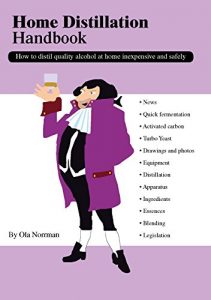Natural Home Distillation
Equipment for fermentation
Fermentation vessel
Fermentation lid
Rubber plug (Bung)
Rubber caps
Fermentation lock
The Siphon
Measuring
The Hydrometer (with Oechslescale)
Hydrometer Instructions
Measuring glass for the alcometer and hydrometer
Alcometer
Laboratory Thermometer
Distillation Apparatus
The Still
Distillation column filling
Counter-flow rinsing of column
Heat source for the still
The Thermometer
Electronic Temperature Control
There are two reliable solutions that function well
The LAB MASTER distilling apparatus
The boiling vessel
Material
Austenitic stainless steel or copper <�/font>
Thermometer connection point
As viewed from base of column
Mounting of column filling Retention strip
Fixing of column filling retention plate
Circulation of cooling water
These pictures are examples of parts purchased for next to nothing from a metal recycler.
Ingredients
Quantities
METRIC / USA / UNITED KINGDOM
CONVERSION
Water
Sugar
Yeast
Yeast Nutrients
Turbo Yeast
Clearing Agents (Finings)
Activated Carbon
Activated carbon is always active
How much activated carbon is used?
Aquarium charcoal
Deposits in the spirit
Essences
The advantages of essences
Which essences are best?
Literature about home distilling
Where to buy essences:
Mash fermentation
Preparing the mash
How much sugar is required?
Purer fermentation with Turbo Yeast
Turbo Yeast
Some Turbo Yeasts and their characteristics
A note about whisky and fruit schnapps
Basic instructions:
What makes for a “good” Turbo?
The key to making world-class spirits and liqueurs in the home
Understanding the science of fermentation
Yeast is a living organism
All about temperature
There are 3 types of temperature we need to talk about:
Some different quality Turbos:
Turbo Yeast instructions for 25 Litres
Some words about quality
A last trick to improve quality
Large volume fermentation
Instructions for large volume fermentation
Mash fermentation with Turbo Yeast
Mash fermentation with baker´s yeast
Distillation
Pressure
Re-distillation
Fractional distillation
How to distil extra pure alcohol
The Amazing Method
Temperature
Effect of atmospheric pressure on boiling points
Theoretical thresholds in a distillation column
The actual location of the thresholds
Distillation procedure
SAFETY: Danger of accidents and other important points
Explosions
Risk of fire
Flooding
Poisoning
Trouble shooting - Distillation fails to start
Dilution
Fusel oil - Facts about fusel oil
Purification using activated carbon
Procedure
Activated Carbon Filtration Unit
Purification using the same activated carbon twice
Purification must be perfect
Free eBook about activated carbon
Different brands of activated carbon
Blending with essences
Blending with spirit essences
Blending with liqueur essences
Formula for calculating dilution
Table of original alcohol content of liqueurs
Original gravity of liqueurs
Original gravity of aperitifs and bitters
Legislation - Freedom of the press
Equipment for fermentation
Fermentation vessel
Fermentation lid
Rubber plug (Bung)
Rubber caps
Fermentation lock
The Siphon
Measuring
The Hydrometer (with Oechslescale)
Hydrometer Instructions
Measuring glass for the alcometer and hydrometer
Alcometer
Laboratory Thermometer
Distillation Apparatus
The Still
Distillation column filling
Counter-flow rinsing of column
Heat source for the still
The Thermometer
Electronic Temperature Control
There are two reliable solutions that function well
The LAB MASTER distilling apparatus
The boiling vessel
Material
Austenitic stainless steel or copper <�/font>
Thermometer connection point
As viewed from base of column
Mounting of column filling Retention strip
Fixing of column filling retention plate
Circulation of cooling water
These pictures are examples of parts purchased for next to nothing from a metal recycler.
Ingredients
Quantities
METRIC / USA / UNITED KINGDOM
CONVERSION
Water
Sugar
Yeast
Yeast Nutrients
Turbo Yeast
Clearing Agents (Finings)
Activated Carbon
Activated carbon is always active
How much activated carbon is used?
Aquarium charcoal
Deposits in the spirit
Essences
The advantages of essences
Which essences are best?
Literature about home distilling
Where to buy essences:
Mash fermentation
Preparing the mash
How much sugar is required?
Purer fermentation with Turbo Yeast
Turbo Yeast
Some Turbo Yeasts and their characteristics
A note about whisky and fruit schnapps
Basic instructions:
What makes for a “good” Turbo?
The key to making world-class spirits and liqueurs in the home
Understanding the science of fermentation
Yeast is a living organism
All about temperature
There are 3 types of temperature we need to talk about:
Some different quality Turbos:
Turbo Yeast instructions for 25 Litres
Some words about quality
A last trick to improve quality
Large volume fermentation
Instructions for large volume fermentation
Mash fermentation with Turbo Yeast
Mash fermentation with baker´s yeast
Distillation
Pressure
Re-distillation
Fractional distillation
How to distil extra pure alcohol
The Amazing Method
Temperature
Effect of atmospheric pressure on boiling points
Theoretical thresholds in a distillation column
The actual location of the thresholds
Distillation procedure
SAFETY: Danger of accidents and other important points
Explosions
Risk of fire
Flooding
Poisoning
Trouble shooting - Distillation fails to start
Dilution
Fusel oil - Facts about fusel oil
Purification using activated carbon
Procedure
Activated Carbon Filtration Unit
Purification using the same activated carbon twice
Purification must be perfect
Free eBook about activated carbon
Different brands of activated carbon
Blending with essences
Blending with spirit essences
Blending with liqueur essences
Formula for calculating dilution
Table of original alcohol content of liqueurs
Original gravity of liqueurs
Original gravity of aperitifs and bitters
Legislation - Freedom of the press






